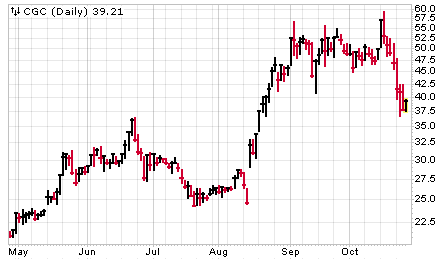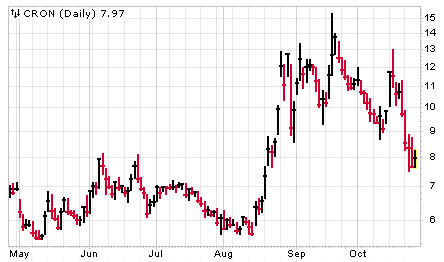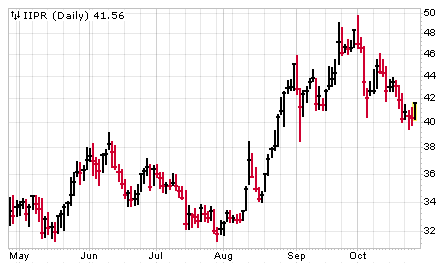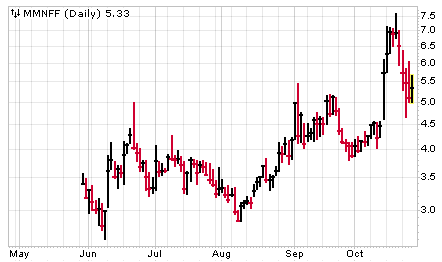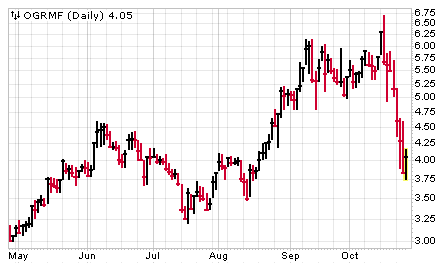Hopefully, you took some profits last week as I advised. It’s been a rough week since then, but it wasn’t unexpected. The well-publicized legalization day in Canada was exactly the type of event that often accompanies market tops.
Of course, it’s not just the marijuana stocks that have been sinking; the broad stock market is trending down as well.
But have no fear! The key to successful investing in this sector is to hold cash when the environment is against you, and to invest in great growth companies when trends are positive, and to take partial profits—as we did last week—when stocks get frothy.
Cabot Marijuana Investor 1018
Is the Correction Over?
Last Tuesday, the day before the opening of the legal commercial market for marijuana in Canada, I sent you an update that said, in part, “I believe the odds are that this will mark an intermediate-term top for many of the stocks in the sector…Thus, I’ll be taking partial profits in all the portfolio’s Canadian producers today (that’s six stocks) by selling half of each position.”
Hopefully, you did the same, because from their highs that day to their lows this Tuesday, the average decline for those six stocks was 41%. That’s quite a drop.
But such volatility is par for the course in this hot sector. And the good news is that this sharp correction has brought five of those six stocks—the one exception being Canopy (CGC), the market leader and institutional favorite—down to their 200-day moving averages. These long-term averages traditionally offer support and thus present good places to buy stocks that are in long-term uptrends.
So does this mean the correction is over?
Probably not.
But there is no certainty, so let me lay out the evidence.
First, when a hot sector goes cold, it takes time for investors to give up on the stocks. Yes, a lot of people jumped out of marijuana stocks over the past week, but many are still holding on, hoping these stocks will bounce back—and the market generally doesn’t make it that easy. Yes, a 41% average drop is a lot, but a week is nothing; the correction after the January peak lasted seven months.
Second, the general stock market is sick. In fact, Cabot’s intermediate-term and long-term trend-following indicators are now both negative, for the first time in 30 months, telling us that the major trends are now down—and when the major trends are down, it’s hard for any one sector to run contrary to that trend for long.
Third, to get a real bottom, ideally we need some very visible ”bad news,” and so far, all I see is good news, both in the marijuana sector and in the general market as well.
So, short-term, my advice is to hold off new buying on most of these stocks and let this correction run its course a little longer. If things perk up, both in the marijuana sector and in the broad market, I’ll be happy to jump right back in, but for now, I’ll stand pat.
Note: When I did that selling last Tuesday, I calculated that the portfolio’s cash position was 38%. But with the subsequent corrections by the stocks—the Canadians in particular—the cash position is now 43%.
Additionally, while our portfolio’s YTD gain last Tuesday was 62%, now it’s shrunk to 44%—while the marijuana index is now down 8% YTD.
Still, the long-term prospects for marijuana stocks remain bright. In fact, just last Thursday, I attended the Cannabis World Congress and Business Expo in Boston, and after hearing dozens of experts speak, I came away with these three conclusions:
1. This boom will be global. Marijuana is now legal in Canada and Uruguay and the U.S. won’t be far behind. After that, the most likely countries to legalize adult-use cannabis are Jamaica, Czech Republic, Colombia, Peru, The Netherlands, Portugal, Spain, Iceland, and France.
2. Once marijuana is legal in the U.S. under federal law, national producers will emerge and become larger than the Canadian companies.
3. The stocks of the Canadian producers are all substantially overvalued relative to U.S. cannabis stocks.
Again, this was last Thursday, before the worst days for the marijuana stocks (and the broad market as well). Valuations are certainly lower now. But my key takeaway remains the same—that I’ve got to identify the eventual leaders of the U.S. market early, and get you on board them at an appropriate buying point.
In the meantime, my plan is to hold all the current stocks in the portfolio long-term, because five years from now, they will be much higher. In fact, when trends turn positive again, I fully expect to reinvest some of our cash in those same stocks (as well as new stocks), at lower prices than where I sold.
Last but not least, I once again want to remind you of a few key principles that will help you be a successful investor in this sector.
1. Diversify, not just among companies but also among business models. Don’t just buy growers; buy retailers and processors and supporting players. Furthermore, when you buy, diversify by spreading out your buying over time.
2. Always be aware of your risk level. The best way to avoid big losses is to buy right.
3. Remember this is a marathon, not a sprint. While there will be major ups and downs in the months ahead, the long-term trend for the industry is clearly up.
WHAT TO DO NOW
Stand pat. I’ll be watching daily to see if both the marijuana sector and the broad market can build bases in the weeks ahead.
CURRENT RECOMMENDATIONS
The portfolio was started with a hypothetical $100,000 on August 22, 2017.
Aphria (APHQF 12)
Third-largest of the Canadian growers, APHQF is the rare stock of the group that failed to get above its January high in recent months—and the upside of that is that its recent correction was the mildest of the group, down “just” 35% from top to bottom. The bad news, however, is that the stock’s 200-day moving average just turned down, and that’s not a good sign.
Last week I told you that a normal correction from here could take the stock down to 12.44 or 11.0, while a major correction could take it to 8, and now we’re smack in the middle of that “normal” range.
Aurora Cannabis (ACB 7.3)
Now trading on the NYSE (which automatically brings more investors to the stock), Aurora is #2 in Canada, thanks in part to some big acquisitions. Also in the mix is the rumor that Coca-Cola is interested, though there’s been no official announcement yet.
As to the stock, it barely topped its January high last week just before the sellers took over, and now it’s met up with its 200-day moving average (around 7.5), which coincides with the stock’s June highs—which should now provide support.
Last week I wrote, “A normal correction from here could take the stock down to 9.1 or 7.5, while a major correction could take it to 6.” So we’re right at the bottom of that “normal” range. But as with APHQF, the 200-day moving average has turned down, so I don’t see any buying urgency here.
Canopy Growth (CGC 40)
Canopy remains the undisputed king of the cannabis industry, not least because of the $4 billion contribution of Constellation Brands (STZ), whose investment kicked off the August blastoff of all stocks in the industry.
That blastoff took the stock from 25 to 57 in just nine weeks, and as I write, the stock has given back roughly half of that gain, which is substantially less of a haircut than the other Canadian growers have received. One likely reason: the presence of long-term oriented institutional investors.
Another good sign: the stock is still well above its 200-day moving average.
Last week I wrote, “A normal correction from here could take the stock down to 50, while a major correction could take it to 35—or even 28.”
Bottom line: CGC has been holding up best of the Canadian growers, and if it maintains that record, great. If not, there’s definitely room to fall as far as 28.
Fundamentally, however, all is fine! Last week Canopy announced the acquisition of Evergreen, Colorado-based ebbu, which uses patented plant genetics to maximize cannabinoid output by “boosting in-plant cannabinoid production and creating rare-cannabinoid-specific plants.” Ebbu’s intellectual property will be used to enhance Canopy Growth’s cannabis genetic breeding program as well as its cannabis-infused beverage capabilities.
Cronos Group (CRON 8.1)
Cronos is the fifth-largest (by market capitalization) of the Canadian marijuana stocks, and it’s a mover! From a low of 5.75 in early August, the stock soared to a high of 15.3 back in mid-September, and then corrected all the way to 7.5 Tuesday before bouncing slightly.
Last week, I wrote, “A normal correction from here could take the stock down to 9.8 or 8, while a major correction could take it to 7.2.” And right now we’re between the two, definitely low, but not trending up yet. Also, the stock’s 200-day moving average is now trending down.
CV Sciences (CVSI 5.0)
CV Sciences is not in the marijuana business; instead it’s the number one seller of cannabidiol (CBD) oil, which is sold across the U.S. in health food stores, marijuana dispensaries and online under the brand Plus +CBD. And most CBD oil comes from hemp, a cousin of marijuana.
So it makes sense that just last week, the company announced that it would partner with the Rodale Institute, the country’s leading organic farming institution, to do research on organic and industrial hemp. CV Sciences currently works with the University of Kentucky and Murray State University, and this new partnership will strengthen the company’s leadership in the field.
As for the stock, it provides a welcome dose of diversification in the portfolio, because it marches to a different drummer. In fact, it’s been tracing out a beautiful tightening basing structure centered on 5 since mid-August. Last week I wrote that CVSI could be bought on any normal pullback, and today that advice stands.
HEXO Corp. (HYYDF 4.3)
Previously known as Hydropothecary, HEXO is the Canadian marijuana grower that has partnered with Molson Coors to put cannabis drinks on shelves in Canada as soon as they’re legal—probably in 2019. (Molson Coors has control of the partnership with 57.5% ownership.)
But that partnership has been no protection from the recent selling; in fact, HYYDF was the worst performer of our six Canadian growers, dropping 48% from last week’s high to Tuesday’s low.
Last week I wrote, “A normal correction from here could take the stock down to 6.0, while a major correction could take it to 4.0.” And in fact HYYDF did briefly fall through 4.0 on Tuesday before rebounding. Odds are very good that it will bottom in this range—but that process is not complete. However, the 200-day moving average is still trending up.
iAnthus Capital (ITHUF 5.0)
iAnthus owns and operates growers, processors and dispensaries in six U.S. states—with a strong focus on the East Coast. That makes it a multi-state, vertically integrated operator, which means it’s insulated from tough conditions in any one state, or tough conditions in any one level of the industry (a glut of supply at the wholesale level, for instance).
And now it’s getting bigger; just last week the company announced the acquisition of MPX Bioceutical for stock valued at $835 million. This expands the company’s footprint to 10 states (Arizona, California, Colorado, Florida, Maryland, Massachusetts, Nevada, New Mexico, New York and Vermont), with 56 retail locations and 14 cultivation/processing facilities.
Notably, this is the first combination of two U.S. public companies in the industry, and increases the odds that the company will be a major retail player in the years ahead.
The stock peaked with the group back in January, broke out to additional new highs in June, and then hit more new highs in September and October as the sector surged. Last week I told you that a normal correction could take the stock down to 4.6, while a major correction could take it to 3.8—and the stock almost touched 4.6 Tuesday. If you don’t own it, buying in the mid-4s looks reasonable.
Innovative Industrial Properties (IIPR 41)
Innovative Industrial Properties is a real estate investment trust (REIT) dedicated to the cannabis industry—and one of the few companies in the portfolio with actual earnings. Thus, in this portfolio of young, volatile high-flyers, IIPR is a relative rock—a rock that’s up 40% YTD.
The company currently has nine properties in seven states, all 100% leased to state-licensed medical use cannabis growers, and is virtually guaranteed to grow as the industry grows—though interest rates are an external risk.
As to the chart, last week I told you that a normal correction could take the stock down to 41 (not far), while a major correction could take it to 38—or even 32. So, sitting at just under 41 today, with the broad environment still negative, the stock does not look attractive for buying yet.
KushCo Holdings (KSHB 5.1)
KushCo is another component of the portfolio that’s here for diversification away from growers as much as anything. The company was originally known as Kush Bottles, and focused on providing containers for the industry, but it’s branched out substantially over the past year.
It now targets the veterinary medicine industry with its containers. It offers design and branding services to complement its containers (many of them child-proof). It offers a wide variety of industrial gasses to cannabis processors, so they can turn harvested product into oils and more. It recently established an office in China to gain better control of its manufacturing relationships there, and it launched a Toronto-based subsidiary to begin to tackle the Canadian market.
All this expansion is possible, of course, because money is flowing into the sector, and KushCo in particular is attractive because all the products it deals with are legal in every state and province.
But last week at the Boston expo, President Jason Vegotsky (founder of the gas company that KushCo acquired) noted that the stock remains deeply undervalued relative to the high-flying Canadian producers. (He also said the company was hiring fast; every morning from 6:00 to 8:00 he conducts five interviews!)
In the fiscal fourth quarter ended August 31 (report not yet filed), revenues grew approximately 171% from the year before to $51 million.
As for the stock, it peaked in January with the crowd, and then set a lower peak in June and a lower one still in September, so KSHB is definitely losing ground relative to the growers. Still, the company’s long-term prospects are attractive.
Last week I told you that a normal correction could take the stock down to 5.2, while a major correction could take it to 4.0, and the stock did hit 4.4 on Tuesday before rebounding with the group. If you don’t own it, you could begin to nibble here.
MedMen (MMNFF 5.3)
MedMen is the biggest cannabis retailer in the U.S., and it’s getting bigger!
Earlier this month, the company acquired Chicago-based PharmaCann, in a stock deal valued at $682 million. Adding MedMen’s 16 marijuana dispensaries in the U.S.—including in California, Nevada, Florida and New York—to PharmaCann’s properties brings the total to 12 states and licenses to operate 79 cannabis facilities.
But MedMen is not just a retailer; it also grows and processes marijuana, and is thus the leading multi-state, vertically integrated company in the industry today.
Additionally, MedMen licensed the Woodstock name this month, and we’ll see what that brand is worth going forward.
Then, just this morning, the company released its fiscal fourth quarter results. Revenue was $20.6 million, up 1,317% from $1.5 million the year before, and up 44% from the third quarter.
Going forward, if MedMen can remain the largest retailer in the industry, this stock will be a huge winner.
Last week I told you that it was hard to say what a normal correction would be, given that the PharmaCann news had sparked a spike higher—but I ventured that 5.8 would be the minimal correction, with 5.0 or even 4.5 possible. And the stock did come close to 4.6 on Tuesday. If you don’t own it, you could start to nibble here.
Organigram (OGRMF 4.2)
Based in the province of New Brunswick, OrganiGram is a mid-size Canadian grower, and possibly the lowest cost producer in Canada.
Partly this is due to the company’s low cost of electricity, but partly it’s due to high yields that come from a very efficient production system, with fully automated irrigation, automated potting, fully automated waste destruction and automated packaging.
The stock peaked in January with the crowd, equaled that peak in June, and then zoomed out to new highs in September and October. Last week I told you that a normal correction from here could take the stock down to 6.0 (that was a typo; it should have been 5.0), while a major correction could take it to 4.2—and this morning the stock was below 4 (and also below Tuesday’s low) which is a sign that support at this lower end of the investment market is weak. Long-term, however, the future is bright, as it is with all these stocks—though if OGRMF gets cheap enough, it could be an attractive acquisition.
Turning Point Brands (TPB 41)
Turning Point is the old-school smokeless tobacco company that has been expanding into the cannabis and vaping markets, primarily through acquisitions of the Zig-Zag brand and several vaping brands, including Vapor Shark, Vapor Beast and International Vapor Group.
That means it’s not only the most established company in the portfolio, it also has the ability to pay a small dividend, currently yielding 0.4%.
Also, the stock does not follow the trends of the big growers’ stocks, which is good for portfolio diversification. (Still, it’s up nearly 100% from the start of the year, even after the recent correction.)
Last week I told you that a normal correction could take the stock down to 39 or 38, and it did touch 39 Tuesday, so that’s good. But I’m not confident that it can hold up here—and if conditions turn for the worse, it could fall to 33.
STOCKS ON WATCH
Tilray (TLRY 110)
Tilray was the hottest marijuana stock on the planet in September—in part because of its Nasdaq listing—and it’s been cooling off since. But it’s still valued at $10 billion, which is more than any other cannabis business on the planet today and the question is whether it’s worth it. You see, Tilray is not a major Canadian grower in the mold of Canopy, but a grower/deal-maker in the medical cannabis industry, selling to medical providers in 10 countries around the world.
I would like to have it in the portfolio, but I remain leery, and will watch to see if the stock can build a base here around 100.
Charlotte’s Web Holdings (CWBHF 11)
Based in Colorado, Charlotte’s Web grows hemp and makes CBD—and claims to be the world’s leading brand by market share, with 2,700 retail locations. The stock came public in September, hit 20 last Tuesday, and is now nearly back to its base at 11.
Namaste Technologies (NXTTF 1.5)
Based in Toronto, Namaste sells vaporizers and smoking accessories via more than 30 websites in more than 20-plus countries. Aiming to be the Amazon of cannabis, it relies heavily on technology. But the stock is still volatile and immature.
THE NEXT CABOT MARIJUANA INVESTOR WILL BE PUBLISHED November 29, 2018
Neither Cabot Wealth Network nor our employees are compensated by the companies we recommend. Sources of information are believed to be reliable, but are in no way guaranteed to be complete or without error. Recommendations, opinions or suggestions are given with the understanding that subscribers acting on the information assume all risks. © Cabot Wealth Network. Copying and/or electronic transmission of this report is a violation of U.S. copyright law. For the protection of our subscribers, if copyright laws are violated, the subscription will be terminated. To subscribe or for information on our privacy policy, call 978-745-5532, visit www.cabotwealth.com or write to support@cabotwealth.com.






